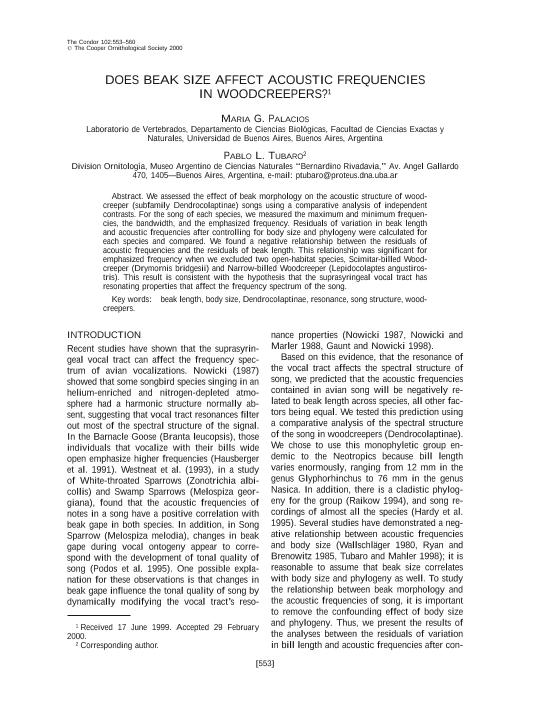Mostrar el registro sencillo del ítem
dc.contributor.author
Palacios, María Gabriela

dc.contributor.author
Tubaro, Pablo Luis

dc.date.available
2018-02-11T22:22:27Z
dc.date.issued
2000
dc.identifier.citation
Palacios, María Gabriela; Tubaro, Pablo Luis; Does beak size affect acoustic frequencies in woodcreepers?; Cooper Ornithological Society; The Condor; 102; 3; 2000; 553-560
dc.identifier.issn
0010-5422
dc.identifier.uri
http://hdl.handle.net/11336/36404
dc.description.abstract
We assessed the effect of beak morphology on the acoustic structure of woodcreeper (subfamily Dendrocolaptinae) songs using a comparative analysis of independent contrasts. For the song of each species, we measured the maximum and minimum frequencies, the bandwidth, and the emphasized frequency. Residuals of variationin beak length and acoustic frequencies after controlling for body size and phylogeny were calculated for each species and compared. We found a negative relationship between the residuals of acoustic frequencies and the residuals of beak length. This relationship was significant for emphasized frequency when we excluded two open-habitat species, Scimitar-billed Woodcreeper (Drymornis bridgesii) and Narrow-billed Woodcreeper (Lepidocolaptes angustirostris).This result is consistent with the hypothesis that the suprasyringeal vocal tract has resonating properties that affect the frequency spectrum of the song.
dc.format
application/pdf
dc.language.iso
eng
dc.publisher
Cooper Ornithological Society

dc.rights
info:eu-repo/semantics/openAccess
dc.rights.uri
https://creativecommons.org/licenses/by-nc-nd/2.5/ar/
dc.subject
Beak Length
dc.subject
Body Size
dc.subject
Dendrocolaptinae
dc.subject
Resonance
dc.subject
Song Structure
dc.subject
Woodcreepers
dc.subject.classification
Zoología, Ornitología, Entomología, Etología

dc.subject.classification
Ciencias Biológicas

dc.subject.classification
CIENCIAS NATURALES Y EXACTAS

dc.title
Does beak size affect acoustic frequencies in woodcreepers?
dc.type
info:eu-repo/semantics/article
dc.type
info:ar-repo/semantics/artículo
dc.type
info:eu-repo/semantics/publishedVersion
dc.date.updated
2017-12-28T13:42:47Z
dc.identifier.eissn
1938-5129
dc.journal.volume
102
dc.journal.number
3
dc.journal.pagination
553-560
dc.journal.pais
Estados Unidos

dc.journal.ciudad
Washington
dc.description.fil
Fil: Palacios, María Gabriela. Universidad de Buenos Aires. Facultad de Ciencias Exactas y Naturales. Departamento de Ecología, Genética y Evolución; Argentina
dc.description.fil
Fil: Tubaro, Pablo Luis. Consejo Nacional de Investigaciones Científicas y Técnicas. Oficina de Coordinación Administrativa Parque Centenario. Museo Argentino de Ciencias Naturales ; Argentina
dc.journal.title
The Condor

dc.relation.alternativeid
info:eu-repo/semantics/altIdentifier/url/http://americanornithologypubs.org/doi/full/10.1650/0010-5422%282000%29102%5B0553%3ADBSAAF%5D2.0.CO%3B2
dc.relation.alternativeid
info:eu-repo/semantics/altIdentifier/doi/http://dx.doi.org/10.1650/0010-5422(2000)102[0553:DBSAAF]2.0.CO;2
Archivos asociados
